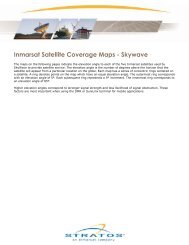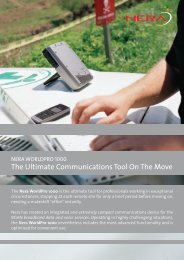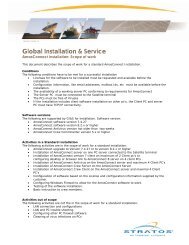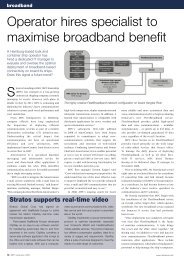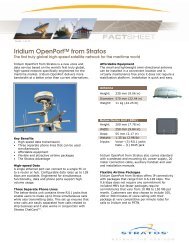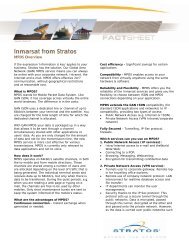Iridium Satellite Data Services White Paper - Stratos Global ...
Iridium Satellite Data Services White Paper - Stratos Global ...
Iridium Satellite Data Services White Paper - Stratos Global ...
You also want an ePaper? Increase the reach of your titles
YUMPU automatically turns print PDFs into web optimized ePapers that Google loves.
<strong>Iridium</strong> <strong>Satellite</strong> <strong>Data</strong> <strong>Services</strong><br />
<strong>White</strong> <strong>Paper</strong><br />
Version 1.0<br />
June 2 nd 2003
WHITE PAPER<br />
Purpose:<br />
This document describes <strong>Iridium</strong> <strong>Satellite</strong>’s current data services. The objective is to provide an<br />
overview of the <strong>Iridium</strong> satellite network, hardware and data services to aid in the selection of an<br />
appropriate data service for a particular integrated data application. This document does not<br />
contain detailed technical information.<br />
Scope:<br />
This white paper covers the following areas<br />
• <strong>Iridium</strong> <strong>Satellite</strong> Network<br />
• <strong>Iridium</strong> Hardware<br />
• <strong>Iridium</strong> Dial-Up <strong>Data</strong><br />
• <strong>Iridium</strong> Direct Internet<br />
• <strong>Iridium</strong> Router Based UDI Connectivity Solution [RUDICS]<br />
• <strong>Iridium</strong> Short Burst <strong>Data</strong> (SBD)<br />
• <strong>Iridium</strong> Short Message Service (SMS)<br />
This paper provides basic system information and parameters; it does not contain a detailed<br />
technical description of each service. This paper assumes a reasonable knowledge of data,<br />
telephony and satellite communications.<br />
IRIDIUM DATA SERVICES 2
WHITE PAPER<br />
<strong>Iridium</strong> <strong>Satellite</strong> Network Overview<br />
The <strong>Iridium</strong> System is a satellite-based, wireless communications network providing a robust suite of<br />
data services to virtually any destination anywhere on earth. The <strong>Iridium</strong> system comprises three<br />
principal components: the satellite network, the ground network and the <strong>Iridium</strong> subscriber products<br />
including phones and pagers. The design of the <strong>Iridium</strong> network allows data to be routed virtually<br />
anywhere in the world. <strong>Data</strong> calls are relayed from one satellite to another until they reach the satellite<br />
above the <strong>Iridium</strong> Subscriber Unit and the signal is relayed back to Earth.<br />
The on-orbit <strong>Iridium</strong> constellation consists of 66 operational<br />
satellites and 14 spares in a constellation of six polar<br />
planes. Each plane has 11 mission satellites performing as<br />
nodes in the telephony network. The 14 additional satellites<br />
orbit as spares ready to replace any unserviceable satellite.<br />
This constellation ensures that every region on the globe is<br />
covered by at least one satellite at all times. The satellites<br />
are in a near-polar orbit at an altitude of 485 miles (780 km).<br />
They circle the earth once every 100 minutes traveling at a<br />
rate of 16,832 miles per hour. Each satellite is cross-linked<br />
to four other satellites; two satellites in the same orbital<br />
plane and two in an adjacent plane. The satellite<br />
constellation is expected to provide continuous global<br />
coverage until 2014.<br />
The ground network is comprised of the System<br />
Control Segment and gateways used to connect into<br />
the terrestrial data networks. The System Control<br />
Segment is the central management component for<br />
the <strong>Iridium</strong> system. It provides global operational<br />
support and control services for the satellite<br />
constellation and delivers satellite tracking data to the<br />
gateways. The System Control Segment consists of<br />
three main components: Four Telemetry Tracking and<br />
Control sites, the Operational Support Network, and<br />
the <strong>Satellite</strong> Network Operation Center. The primary<br />
linkage between the System Control Segment, the<br />
satellites, and the gateways is via K-Band feeder links<br />
and cross-links throughout the satellite constellation.<br />
Gateways are the terrestrial infrastructure that provides interconnection to<br />
the terrestrial data networks. Gateways also provide network management<br />
functions for their own network elements and links.<br />
IRIDIUM DATA SERVICES 3
WHITE PAPER<br />
<strong>Iridium</strong> <strong>Satellite</strong> LLC Distribution Channels<br />
<strong>Iridium</strong> has established a number of distribution channels for its services and products. The intent with<br />
each channel is to maximize either the distribution of existing products and services or to enable products<br />
and services to be integrated into specific vertical market applications. Specific descriptions of each<br />
channel are included below. Information on how to contact a distribution partner of the <strong>Iridium</strong> can be<br />
found on the <strong>Iridium</strong> web site at http://www.iridium.com.<br />
<strong>Iridium</strong> Service Partner (SP)<br />
SPs typically sell <strong>Iridium</strong> products and services through a distribution channel that encompasses both<br />
regional and vertical market attributes. SP’s typically sell handsets or specific vertical market<br />
implementations of handsets (e.g. a maritime or aviation version) along with voice and basic circuit<br />
switched data services.<br />
<strong>Iridium</strong> Value Added Reseller (VAR)<br />
VARs incorporate a specific <strong>Iridium</strong> Subscriber Unit and service into a complete end to end solution for a<br />
particular customer or vertical market. A VAR is a company that provides a total wireless data solution for<br />
an end customer. They integrate all hardware and software for both the remote device as well as the<br />
back office/host computer system. VARs also directly sell <strong>Iridium</strong> <strong>Satellite</strong> <strong>Data</strong> <strong>Services</strong> with their<br />
solution. <strong>Iridium</strong> directly supports <strong>Iridium</strong> VARs with technical information.<br />
<strong>Iridium</strong> VARs are selected based upon experience, a repeatable business case and other factors.<br />
<strong>Iridium</strong> Value Added Manufacturer (VAM)<br />
A VAM is a company that has particular expertise in a vertical market and wishes to integrate an <strong>Iridium</strong><br />
voice or data module into a finished or OEM product. VAMs do not resell voice or data services directly<br />
from <strong>Iridium</strong>. <strong>Iridium</strong> directly supports VAMs with technical information.<br />
IRIDIUM DATA SERVICES 4
WHITE PAPER<br />
<strong>Iridium</strong> Hardware<br />
The Motorola <strong>Satellite</strong> Series 9522 L-Band Transceiver (LBT) is intended for incorporation into an<br />
integrated data solution or product. The LBT is simply the core modem that is required in order to<br />
communicate over the <strong>Iridium</strong> network. Additional components are required such as power supply,<br />
antenna, environmental protection and the serial based interface between the LBT and the customer’s<br />
application.<br />
The LBT provides two interfaces for data applications. A TNC connector is provided for the RF<br />
connection to the antenna. A DB25 connector is provided for power, on/off control and a RS232 port.<br />
Basic Specifications:<br />
Dimensions<br />
Value<br />
Length (including antenna connector) 216.1 mm (8.51")<br />
Length (excluding antenna connector) 196.4 mm (7.73")<br />
Width 82.6 mm (3.25")<br />
Depth 39.0 mm (1.54")<br />
Weight (approximate)<br />
610 g<br />
DC Power Input Specifications<br />
Main Input Voltage - Range<br />
Main Input Voltage - Nominal<br />
Main Input Voltage - Ripple<br />
Peak Input Current (maximum)<br />
Main Input Active Power (average)<br />
Main Input Standby Power (average)<br />
Value<br />
+4.0 VDC to +4.8 VDC<br />
4.4 VDC<br />
40 mVpp<br />
2.5 A @ 4.4 VDC<br />
2500 mW<br />
210 mW<br />
IRIDIUM DATA SERVICES 5
WHITE PAPER<br />
<strong>Iridium</strong> Dial-Up <strong>Data</strong> Service<br />
Service Description<br />
<strong>Iridium</strong> Dial-Up <strong>Data</strong> Service is an asynchronous, circuit switched, 2400 bits per second, bi-directional<br />
service. <strong>Data</strong> calls can be originated:<br />
• From an <strong>Iridium</strong> Subscriber Unit (ISU) to the Public Switched Telephone Network (PSTN) as<br />
shown in Figure 1<br />
• From the PSTN to an ISU as shown in Figure 1<br />
• From one ISU to another ISU as shown in Figure 2<br />
An RS232C interface with AT Commands is used for making a data call. <strong>Data</strong> connections to the PSTN<br />
operate at 2400 bits per second. Terminating PSTN modems should be configured to start negotiating at<br />
4800bps in order to minimize modem negotiation time. A document detailing the AT Commands is<br />
available to authorized developers.<br />
Figure 1<br />
A Circuit Switched <strong>Data</strong> Call from a remote application (ISU) to the PSTN.<br />
5<br />
2<br />
4<br />
1<br />
Remote<br />
Application<br />
using the LBT<br />
2<br />
<strong>Iridium</strong> Gateway 3 4<br />
PSTN<br />
5<br />
Host<br />
Application<br />
D900<br />
Sequence of Events:<br />
1. Application dials number on PSTN using AT Commands (e.g. 0044171……)<br />
2. Call request is routed over the constellation for user authentication and call set-up (~5 sec)<br />
3. Switch makes connection to dialed number (~5 sec)<br />
4. Analog modem in gateway and analog modem in host application synchronize (~30 sec).<br />
5. End-to-End connection established, over the constellation, between the Host Application and Mobile<br />
Application<br />
Note that it is also possible to for the Host Application to initiate the call to the remote application by<br />
dialing the MSISDN-C of the remote application beginning with the International dialing prefix followed by<br />
the <strong>Iridium</strong> Country code number (8816) and the eight digit number.<br />
IRIDIUM DATA SERVICES 6
WHITE PAPER<br />
Figure 2<br />
A Circuit Switched <strong>Data</strong> Call between two ISUs.<br />
2<br />
3<br />
5<br />
3<br />
1<br />
Mobile<br />
Application<br />
(MA#1)<br />
2<br />
<strong>Iridium</strong> Gateway 2<br />
D900<br />
Inter-Working<br />
Equipment<br />
5<br />
4<br />
Mobile<br />
Application<br />
(MA#2)<br />
Sequence of Events:<br />
1. Mobile Application #1 dials MSISDN or MSISDN-C of MA#2<br />
2. MA#1 call is set-up and connected to inter-working equipment<br />
3. Ring alert and call set-up issued by gateway to MA#2<br />
4. MA#2 answers incoming call request (total set-up ~25 sec)<br />
5. End-to-End connection established between MA#1 & MA#2<br />
Dial-Up <strong>Data</strong> Applications<br />
Dial-up data is suitable for applications that require direct computer-to-computer or device-to-device<br />
connections. Each device or computer should be connected to a PSTN modem or an ISU.<br />
Sample applications for this type of service include:<br />
• Connecting Remote Terminal Units (RTUs) to central control and monitoring systems.<br />
• Connecting monitoring equipment to central data collection systems.<br />
• Continuous real time transfer of data.<br />
• Dialing into an Internet Service Provider.<br />
• Dialing into a LAN (Local Area Network.)<br />
IRIDIUM DATA SERVICES 7
WHITE PAPER<br />
<strong>Iridium</strong> Direct Internet Service<br />
Service Description<br />
Direct Internet is a service that allows a subscriber with a Windows-based computer to access the<br />
Internet over the <strong>Iridium</strong> network using an optimized circuit switched data channel. If the destination<br />
computer is a computer connected to the Internet and has an Internet Protocol (IP) address then the<br />
<strong>Iridium</strong> Direct Internet Service is usually the best option if the remote user is using a standard Windows<br />
based operating system.<br />
Figure 3<br />
A Direct Internet <strong>Data</strong> Call from a remote application (ISU) to the Internet.<br />
2<br />
Figure 3<br />
1, 3,4<br />
Mobile<br />
Application<br />
(MA#1)<br />
Sequence of Events:<br />
<strong>Iridium</strong> Gateway<br />
D900<br />
2,3<br />
Internet<br />
Server<br />
Internet<br />
1. MA#1 client Direct Internet Software dials the number for the Direct Internet Server<br />
2. MA#1 call is set-up and connected to the Direct Internet Server<br />
3. MA#1 negotiates connection protocol and authenticates with Direct Internet Server (~ 12 seconds)<br />
4. Standard Internet applications software can then access the Internet<br />
Direct Internet uses “on-the-fly” data compression to increase the effective data throughput. The<br />
compression ratio depends on the type of data being sent or received; text is highly compressible<br />
whereas JPEG graphics files are not compressible. Although the underlying channel rate is 2400bps, the<br />
effective throughput can reach 10,000bps. Direct Internet connections can only be originated from an<br />
ISU. Connections to an ISU cannot be originated from the Internet. Figure 3 illustrates the call path.<br />
Direct Internet software is compatible with many applications that work under Windows Dial-Up<br />
Networking. An additional feature of Direct Internet is that it can automatically terminate the airtime call if<br />
no data traffic has been sent or received within a user specified window. This is called spoofing. Currently<br />
supported Windows versions include Windows 95, 98, NT4.0, Me, 2000 and XP. SmartConnect is a<br />
feature that will automatically re-establish a dropped call and resume data transfer at the point where the<br />
transfer had terminated. .<br />
IRIDIUM DATA SERVICES 8
WHITE PAPER<br />
Direct Internet Service Applications<br />
Typical applications include:<br />
• Email – Send and receive email using Outlook, Eudora or other email client<br />
• FTP (File Transfer Protocol) for transferring data files.<br />
• Web browsing – primarily on text based sites.<br />
• Telnet sessions<br />
Note that additional configuration may be required in order to optimize the throughput of any particular<br />
application.<br />
IRIDIUM DATA SERVICES 9
WHITE PAPER<br />
<strong>Iridium</strong> Point-to-Point Protocol (PPP) Service<br />
Service Description<br />
PPP is essentially a hybrid between the Direct Internet <strong>Data</strong> service and the Dial-Up <strong>Data</strong> service. The<br />
user sets up a standard Dial-Up Networking connection that dials directly into the Direct Internet server,<br />
thus eliminating the analog modems required in a PSTN connection. Since PPP does not utilize the<br />
Direct Internet software, it does not provide the enhancements of Spoofing, SmartConnect or<br />
compression. The advantage of this service is that you have the stability of a Direct Internet call without<br />
having to load the Direct Internet software on the client side. Set-up times of calls are reduced and the<br />
percentage of established calls is significantly higher than using the PSTN to connect to an ISP.<br />
This service only works when a call is originated by an ISU to the PPP server in the gateway. The PPP<br />
server cannot call the ISU. The ISU is not assigned an IP address. Figure 4 illustrates the call path.<br />
PPP service is designed for use in applications where a computing device needs to connect to a<br />
computer via to the Internet. Direct Internet relies on software that only supports Windows operating<br />
systems. Third party PPP protocol software is available from other sources for many computing platforms<br />
and devices. Note that <strong>Iridium</strong> only provides limited support for use of the PPP Service.<br />
Figure 4<br />
A PPP <strong>Data</strong> Call from a remote application (ISU) to the Internet.<br />
2<br />
Figure 4<br />
1, 3,4<br />
Mobile<br />
Application<br />
(MA#1)<br />
Sequence of Events:<br />
<strong>Iridium</strong> Gateway<br />
D900<br />
2,3<br />
PPP Internet<br />
Server<br />
Internet<br />
1. MA#1 dials the number for the PPP Server<br />
2. MA#1 call is set-up and connected to the PPP Server<br />
3. MA#1 negotiates the PPP connection protocol<br />
4. Standard Internet applications software can then access the Internet via the TCP/IP stack<br />
IRIDIUM DATA SERVICES 10
WHITE PAPER<br />
PPP Service Applications<br />
<strong>Iridium</strong> PPP service is designed to serve two types of applications:<br />
1) Direct connection to the Internet for non-Windows based computing platforms. Linux, Apple, Palm<br />
and other operating systems can be configured to use a PPP client for communication to the Internet.<br />
[Windows based applications should use <strong>Iridium</strong> Direct Internet Service.]<br />
2) Application specific data communications for telemetry, remote monitoring or tracking of field based<br />
assets.<br />
Non-Windows based systems, with typical applications utilizing the Internet, include email, file transfer,<br />
telnet and other terminal sessions. PPP service allows connection to any publicly available IP address on<br />
the Internet.<br />
For specific applications, this service could be used with an <strong>Iridium</strong> 9522 L-Band Transceiver in an<br />
integrated application. An applications developer could integrate the service and hardware to provide<br />
data connectivity from a remote or mobile application to an IP address over the <strong>Iridium</strong> network.<br />
IRIDIUM DATA SERVICES 11
WHITE PAPER<br />
<strong>Iridium</strong> Router based Unrestricted Digital Interworking<br />
Connectivity Solution [RUDICS]<br />
Service Description<br />
RUDICS is a circuit switched data service designed to be incorporated into an integrated data solution.<br />
Integrated data solutions are applications such as remote asset monitoring, control, and data file transfer.<br />
Often these applications are designed to support hundreds or thousands of remote units. The other circuit<br />
switched data services mentioned in this paper are sometimes sub-optimal for such applications.<br />
RUDICS is designed to take advantage of the global nature of the <strong>Iridium</strong> communications system and<br />
combine that with a modern digital connection between the <strong>Iridium</strong> Gateway and the Value Added<br />
Resellers centralized application server or Host Application.<br />
RUDICS uses the same circuit switched data service that is described in the sections on “Dial-Up <strong>Data</strong>”<br />
and Direct Internet. The difference and key benefit comes in the equipment used to terminate or originate<br />
the call in the <strong>Iridium</strong> Gateway.<br />
Figure 5 illustrates the call path for a Mobile Originated call.<br />
Figure 5<br />
A RUDICS <strong>Data</strong> Call from a remote application (ISU) to the central Host Application<br />
5<br />
2<br />
2<br />
<strong>Iridium</strong> Gateway 3<br />
4<br />
5<br />
4<br />
Host<br />
Application<br />
1<br />
Mobile<br />
Application<br />
D900<br />
RUDICS<br />
Server<br />
Internet<br />
OR<br />
Leased<br />
Line<br />
Sequence of Events:<br />
1. Mobile application places call to a custom RUDICS Server Number<br />
2. Call request is routed over the constellation for user authentication and call set-up.<br />
3. Switch connects to RUDICS Server, secondary authentication conducted<br />
4. RUDICS Server terminates call to pre-configured IP Address<br />
5. End-to-End IP connection established, over the constellation, between the Host Application and<br />
Mobile Application<br />
IRIDIUM DATA SERVICES 12
WHITE PAPER<br />
Figure 6 illustrates the call path for a Mobile Terminated call.<br />
Figure 6<br />
A RUDICS <strong>Data</strong> Call from a central Host Application to the remote application (ISU).<br />
5<br />
4<br />
4<br />
4<br />
<strong>Iridium</strong> Gateway<br />
3<br />
2<br />
5<br />
4<br />
1<br />
Host<br />
Application<br />
Mobile<br />
Application<br />
D900<br />
RUDICS<br />
Server<br />
Internet<br />
OR<br />
Leased<br />
Line<br />
Sequence of Events:<br />
1. Host application places telnet call to RUDICS Server<br />
2. RUDICS Server Authenticates Host<br />
3. Call request is routed to the switch for call set-up<br />
4. Call request is routed over the constellation for user authentication and call set-up.<br />
5. Mobile Application answers call. End-to-End IP connection established, over the constellation,<br />
between the Host Application and Mobile Application<br />
RUDICS uses routers to allow termination and origination of circuit switched data calls to and from a<br />
specific IP address via a Telnet protocol. The capability is designed to support applications that have<br />
many field devices and one central host application. The service allows field devices to directly call the<br />
host application and the host application is able to directly call the field devices.<br />
Connectivity between the <strong>Iridium</strong> Gateway and the Host Application can be by a variety of methods,<br />
including Internet, Virtual Private Network and Leased Line<br />
IRIDIUM DATA SERVICES 13
WHITE PAPER<br />
RUDICS has a number of advantages over other methods of originating and terminating Circuit Switched<br />
<strong>Data</strong> calls on <strong>Iridium</strong>. The following table describes some of these advantages:<br />
Service Type Limitation RUDICS Advantage<br />
Dial Up <strong>Data</strong> Analog modem training time No modem training time and therefore<br />
lower cost per call<br />
Dial Up <strong>Data</strong><br />
Direct Internet<br />
PSTN origination fee set by long distance or<br />
international carrier<br />
Remote unit must initiate session. Unit<br />
cannot be called directly from an IP Address<br />
Service rates are identical for Mobile<br />
Originated or Mobile Terminated calls<br />
Calls can be Mobile Originated and<br />
Mobile Terminated<br />
Direct Internet Requires Windows Operating System No Operating System requirement<br />
Direct Internet Remote unit IP address is non-routable Routable IP addresses.<br />
Direct Internet<br />
TCP/IP Stack negotiation uses billable<br />
airtime<br />
Application vendor can select<br />
appropriate protocol<br />
PPP Service Requires TCP/IP Stack No TCP/IP Stack Required<br />
PPP Service<br />
Remote unit must initiate session. Unit<br />
cannot be called directly from an IP Address<br />
Calls can be Mobile Originated and<br />
Mobile Terminated<br />
PPP Service Remote unit IP address is non-routable Routable IP addresses.<br />
PPP Service<br />
TCP/IP Stack negotiation uses billable<br />
airtime<br />
Application vendor can select<br />
appropriate protocol<br />
IRIDIUM DATA SERVICES 14
WHITE PAPER<br />
RUDICS Service Applications<br />
Typical applications include:<br />
• Email – Sending and receiving of email using custom applications software<br />
• FTP (File Transfer Protocol) for transferring data files.<br />
• Periodic data reporting by remote sensors<br />
• Polling of remote units to collect data<br />
• Control of remote equipment<br />
Note that RUDICS is typically best suited for applications that deploy more than 500 units, which<br />
report to a central host application.<br />
IRIDIUM DATA SERVICES 15
WHITE PAPER<br />
<strong>Iridium</strong> Short Burst <strong>Data</strong> (SBD) Service<br />
Service Description<br />
<strong>Iridium</strong> Short Burst <strong>Data</strong> (SBD) Service is an efficient network protocol designed for shorter sized data<br />
messages than can be economically sent via <strong>Iridium</strong> Circuit Switched <strong>Data</strong> <strong>Services</strong>. SBD uses a<br />
proprietary network protocol to transfer data messages to and from the remote terminal. An overview is<br />
shown in Figure 7.<br />
It is possible to send Mobile Originated (MO-SBD) and Mobile Terminated (MT-SBD) messages.<br />
Message size for MO-SBD is between 1 and 1960 bytes. (0 byte messages are referred to as “mailbox<br />
checks.”) Message size for MT-SBD is between 1 and 1890 bytes.<br />
The target vertical markets for SBD are Oil, Gas, Rail, Maritime, Aeronautical, and Utility industries as<br />
well as applications in the Government and Military sectors. <strong>Iridium</strong> itself does not provide complete endto-end<br />
solutions. However, it looks to selectively partner with skilled Value Added Resellers (VARs) to<br />
integrate the required hardware, software, and SBD service that ultimately forms the complete packaged<br />
solution for the end customer.<br />
Remote Applications send Mobile Originated SBD (MO-SBD) data messages via an <strong>Iridium</strong> 9522 L-Band<br />
Transceiver (“LBT”). The application microcontroller or microprocessor communicates with the LBT using<br />
AT commands over an RS232 serial port. The application loads the data message into the LBT and<br />
instructs it to send the data message. The data message is transmitted across the <strong>Iridium</strong> satellite<br />
network utilizing inter-satellite links to reach the <strong>Iridium</strong> Gateway. From there the data message is<br />
transferred via e-mail to the VARs host computer system. Here the message is stored in a database for<br />
further data processing.<br />
Mobile Terminated SBD (MT-SBD) messages are sent to the <strong>Iridium</strong> Gateway via e-mail from the VARs<br />
host computer system. MT-SBD data messages are delivered to the LBT following a MO-SBD or “mailbox<br />
check” initiated by the remote application.<br />
The maximum length of a MO-SBD message is 1960 bytes. The maximum length of a MT-SBD message<br />
is 1890 bytes. <strong>Global</strong> network transmit latency for delivery of messages ranges from approximately 5<br />
seconds for short messages to approximately 20 seconds for maximum length messages. This latency is<br />
the elapsed time before the <strong>Iridium</strong> SBD system sends the SBD message to its email destination.<br />
Additional latency introduced by the Internet or the customer’s host system is not in <strong>Iridium</strong>’s control.<br />
IRIDIUM DATA SERVICES 16
WHITE PAPER<br />
Figure 7<br />
A SBD <strong>Data</strong> Call from a remote application (ISU) to the Internet.<br />
5<br />
Internet<br />
Email<br />
4,5<br />
Sensor or<br />
other<br />
inputs/outputs<br />
1,2,3,7,9<br />
Microprocessor<br />
Based<br />
System<br />
Mobile<br />
Application<br />
[MA]<br />
2,7,8<br />
<strong>Iridium</strong> L-Band<br />
Transceiver<br />
RS232 Serial<br />
Interface<br />
<strong>Iridium</strong> Gateway<br />
3,6,8<br />
SBD Network<br />
Equipment<br />
Value Added Reseller<br />
Host System<br />
End User Applications<br />
Sequence of Events: MO-SBD<br />
1. MA loads the MO-SBD data message into the L-Band Transceiver.<br />
2. MA instructs the L-Band Transceiver to send the SBD Message to the <strong>Iridium</strong> Gateway<br />
3. <strong>Iridium</strong> Gateway SBD Equipment receives the SBD Message; sends an acknowledgement to the MA<br />
and creates an email message with the SBD data message as an attachment to the email.<br />
4. Email message is sent to the destination email server hosted by the Value Added Reseller for<br />
processing of the data message.<br />
Sequence of Events: MT-SBD<br />
5. Email message is sent to the <strong>Iridium</strong> Gateway server by the Value Added Reseller’s Host Server.<br />
6. <strong>Iridium</strong> Gateway SBD Equipment receives the MT-SBD Message and stores it in a database.<br />
7. The MA initiates a “Mailbox Check” and the MT-SBD Message is downloaded to the L-Band<br />
Transceiver.<br />
8. The L-Band Transceiver sends an acknowledgement to the <strong>Iridium</strong> Gateway that the MT-SBD<br />
Message has been delivered.<br />
9. MA extracts the MT-SBD Message from the L-Band Transceiver and processes the message.<br />
IRIDIUM DATA SERVICES 17
WHITE PAPER<br />
<strong>Iridium</strong> SBD Service Applications<br />
<strong>Iridium</strong> SBD Service is designed to serve a range of applications that need to send data messages that<br />
on average are typically less than 300 bytes.<br />
Specific applications may include:<br />
• Flight following for aircraft and helicopters<br />
• Tracking and messaging for maritime vessels<br />
• Tracking of mobile land based assets such as trucks and heavy equipment<br />
• Monitoring of equipment on oil and gas pipelines<br />
• Monitoring of equipment of water, gas and electric utility distribution networks<br />
IRIDIUM DATA SERVICES 18
WHITE PAPER<br />
<strong>Iridium</strong> Short Message Service (SMS)<br />
Service Description<br />
Short Message Service is a GSM based system capability designed for both Mobile Origination (MO) and<br />
Mobile Termination (MT) of short text messages. There are numerous GSM-SMS applications developed<br />
for terrestrial GSM networks. It should be possible to adapt existing terrestrial based applications and<br />
also develop new applications using the <strong>Iridium</strong> SMS service.<br />
The <strong>Iridium</strong> SMS service offers the following capabilities:<br />
• Two-way global text messaging.<br />
• Send to and receive from other <strong>Iridium</strong> SMS subscribers.<br />
• Send to and receive from email addresses. <strong>Iridium</strong> subscribers are able to receive SMS<br />
messages via @msg.iridium.com, where is the <strong>Iridium</strong> phone number.<br />
• Send to and receive from cellular subscribers (when available.)<br />
• 160 characters per message.<br />
• Messages will be stored until delivered (up to 8 days.)<br />
• Supported on 9505 handsets and 9522 LBTs with SMS capable firmware.<br />
• SMS messages can be entered into the phone in one of two ways:<br />
• Via the phone’s keypad<br />
• Via the phone’s data port, using standard AT commands<br />
<strong>Iridium</strong> SMS Service Applications<br />
The <strong>Iridium</strong> SMS Service can be used to serve a range of applications that can send useful information<br />
within the 160-character limit of each message.<br />
Specific applications may include:<br />
• Weather information & alerts<br />
• Schedule information<br />
• News & Sports information<br />
• Personal messaging<br />
• Basic email messaging<br />
• Monitoring of remote applications<br />
IRIDIUM DATA SERVICES 19
WHITE PAPER<br />
• Choosing A <strong>Data</strong> Service<br />
There are many reasons that a particular data service may be chosen. The purpose of the table<br />
below is to assist in narrowing down the choices and is not an exhaustive selection matrix. In addition<br />
to technical details, commercial information such as the usage profile and service pricing is also<br />
required in order to determine the most appropriate data service.<br />
Service Name Typical Use Transfer Type<br />
Direct Internet<br />
Dial-Up <strong>Data</strong><br />
PPP Service<br />
RUDICS<br />
Short Burst <strong>Data</strong><br />
Direct Internet<br />
Dial-Up <strong>Data</strong><br />
RUDICS<br />
Short Burst <strong>Data</strong><br />
Short Burst <strong>Data</strong><br />
RUDICS<br />
Short Burst <strong>Data</strong><br />
Direct Internet<br />
Dial-Up <strong>Data</strong><br />
PPP<br />
Remote access to Internet based personal email service<br />
using a Windows based computer<br />
Remote access to a corporate email service not<br />
connected to the Internet<br />
Access to the Internet by a computer without a Windows<br />
Operating System<br />
Large scale monitoring of fixed or mobile assets beyond<br />
typical terrestrial coverage<br />
File transfers that typically are 500 bytes or more per<br />
transfer<br />
File transfers that typically are less than 500 bytes per<br />
transfer<br />
Frequent short file transfers [Less than 500 bytes]<br />
Integrated data applications<br />
General ad-hoc file transfer [Human to Machine]<br />
Human to<br />
Machine<br />
Human to<br />
Machine<br />
Human to<br />
Machine<br />
Machine to<br />
Machine<br />
Machine to<br />
Machine<br />
Machine to<br />
Machine<br />
Machine to<br />
Machine<br />
Machine to<br />
Machine<br />
Human to<br />
Machine<br />
Short Message Service Send or receive short email (text message) Human to Human<br />
IRIDIUM DATA SERVICES 20
WHITE PAPER<br />
List of Abbreviations<br />
ISU – <strong>Iridium</strong> Subscriber Unit<br />
ISP – Internet Service Provider<br />
LBT – L-Band Transceiver<br />
MO – Mobile Originated<br />
MT – Mobile Terminated<br />
PPP – Point to Point Protocol<br />
PSTN – Public Switched Telephone Network<br />
RF – Radio Frequency<br />
RUDICS – Router based Unrestricted Digital Interworking Connectivity Solution<br />
SBD – Short Burst <strong>Data</strong><br />
SIM – Subscriber Identity Module<br />
VAM – Value Added Manufacturer<br />
VAR – Value Added Reseller<br />
Further Information<br />
To contact <strong>Iridium</strong> <strong>Satellite</strong>:<br />
In the USA please call: 1-866-947-4348<br />
Outside of the USA please call: +1-480-752-5155<br />
Or email to info@iridium.com<br />
Or visit our web site at www.iridium.com<br />
All Trademarks are the property of their respective owners.<br />
Motorola, the Motorola logo, and the <strong>Satellite</strong> Series logo are trademarks of Motorola.<br />
© 2003 <strong>Iridium</strong> and the <strong>Iridium</strong> logo are registered trademarks and service marks of <strong>Iridium</strong> <strong>Satellite</strong><br />
LLC.<br />
IRIDIUM DATA SERVICES 21



